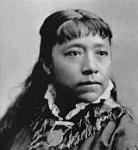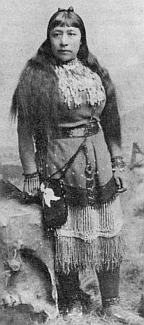| As U.S. government policy toward the Paiutes became harsher, peaceful relations were more tenuous; even so, Winnemucca's father, Chief Winnemucca, believed in avoiding conflict with white settlers and the military, keeping his people away from areas where conflict might arise. Winnemucca inherited a leadership role, serving as translator, interpreter, lecturer, lobbyist, and spokesperson for her people for much of her adult life. Her autobiographical work, Life among the Piutes: Their Wrongs and Claims (1883), in many ways amplifies that role. Life among the Piutes documents the history of contact and reveals a series of betrayals and broken promises that frequently marked Native American and white relations. Although most of the Northern Paiutes did not resist their removal to a reservation in the 1850s, little was offered them in exchange for their traditional nomadic way of life that included seasonal hunting and gathering. Rather, the best of the arable land set aside for them was frequently occupied by white squatters, and the government agents who were in charge of the reservations often profited by leasing portions of the reservation to white ranchers, by selling the government goods designated for the tribe, and by not paying tribal members for their agricultural labor. Winnemucca describes these injustices and reserves her harshest criticism of white society for these corrupt government agents. Decimated by hunger, disease, and attacks by white settlers, the Paiute tribe saw its population dwindle during the years of Winnemucca's adulthood. By the time she was twenty-four, Winnemucca was working as a scout for the U.S. army and an interpreter for Camp McDermitt, an army post in Nevada. Because of her grandfather's influence, she had spent her early teenage years living and working with a white family in Genoa, Nevada, learning to speak fluent English, and apparently, although little is known about her education, to read and write. Because she also knew the languages of the neighboring tribes—Shoshone and Bannock—Winnemucca was extremely valuable to the army as an interpreter. Her skills made her equally valuable to her own eople, as frequent misunderstandings and conflicts arose between the government agents and her tribe. At one point, as she relates in the text, one of her tribesmen begs her to speak for them, saying, "[Y]ou are the only one that is always ready to talk for us." The Paiutes respected the absolute truthfulness of a person's word, written or spoken, thus the importance of Winnemucca being chosen to speak for her tribe. Winnemucca's willingness to "talk for" her tribe led her to lecture publicly about the Paiutes in the hope of changing the white perception that her people were "savages" and remedying the injustices they experienced. Tapping into white curiosity about Indian royalty, she billed herself as "Princess Sarah" and spoke before audiences in San Francisco. In a less theatrical position, she also travelled to Washington, D.C., in 1880, with her father, her brother, and other important members of her tribe to negotiate a more safe and stable life for her people. Winnemucca returned to the East Coast for a lecture tour in 1883, already a well-known personality. Her cause had been taken up by two sympathetic Boston sisters, Elizabeth Peabody and Mary (Peabody) Mann, who had been abolitionists, and who, because of their connections, were very helpful in guiding Winnemucca's public life. While Winnemucca's lectures were successful, she felt that what she said was frequently incomplete, and so, with the editorial assistance of Mary Mann, she wrote Life among the Piutes: Their Wrongs and Claims in 1883. The profits from both the lectures and the book went toward a fund for a school that Winnemucca had envisioned, teaching Paiute children English and white skills, but in the Paiute way. Winnemucca eventually returned to Nevada after raising enough money and started a school at her brother's ranch. Although the school was briefly successful, financial problems and conflicts with the government, which insisted that Paiute students attend a government-run boarding school in Colorado, forced the school to close. After the death of her husband, Lewis Hopkins, in 1887, Winnemucca lived with her widowed sister on her ranch in Howard's Lake, Idaho. There, she died quietly in 1891. As with her lectures, Winnemucca's audience for her autobiography was largely educated and liberal, former abolitionists in some cases, reformers of various sorts, and, frequently, women. By demonstrating to this audience that both she, as an individual, and the Paiutes, as a people, were human beings deserving their sympathy, Winnemucca hoped that her audience would rally to her support and intervene as citizens to the extent that they could in shaping a sympathetic government policy toward the tribe. Such goals inevitably shaped the tone and, to some degree, the structure of the text. Winnemucca frequently appeals directly to her audience within her narrative, as when she exclaims, "Oh, my dear good Christian people, how long are you going to stand by and see us suffer at your hands?" Repeatedly, she demonstrates that the Paiutes share the virtues of civilized culture, but few of its vices. Winnemucca insists that the failure of the Paiutes to adapt to white ways has little to do with their ability or willingness, but has more to do with the corruption of the Indian agents who refuse to make such an assimilation possible. In a letter Winnemucca wrote to the U.S. government in 1870, collected in Helen Hunt Jackson's A Century of Dishonor (1885), she summarizes her hopes for her people: "[I]f the Indians have any guarantee that they can secure a permanent home on their own native soil, and that our white neighbors can be kept from encroaching on our rights, after having a reasonable share of ground allotted to us as our own, and giving us the required advantages of learning, I warrant that the savage (as he is called today) will be a thrifty and law- abiding member of the community fifteen or twenty years hence." Clearly, Winnemucca saw adaptation to white ways as the best means of survival for her tribe. While her assimilationist attitude has earned her much criticism, readers need to keep in mind that she was writing for an audience who, by and large, believed that the Indians would die out if they failed to assimilate. Few, if any, whites at the time recognized any tribe as having a coherent culture of their own, especially hunter-gatherer tribes like the Paiutes, who had not developed a warrior culture, like some of the tribes of the plains, nor a pueblo culture, like some of the tribes of the Southwest, both of whom had values recognizable to white society. Known as "diggers," the Northern Paiutes were perceived as remnants of the stone age, at best, not likely to survive in an era of railroads and developing technologies. Winnemucca recognized the need to create empathy with her readers on the basis of a common humanity and strove to emphasize her people's similarities to, rather than differences from, the dominant culture: hence, the assimilationist tone of her text. As a personal chronicle and the first autobiography of an American Indian woman, the narrative is charged with the personality of an exceptionally dynamic individual. Winnemucca, more than other nineteenth-century women autobiographers, focuses on her public life rather than her private life. Having a public life and an outspoken voice meant going against the conventions of female behavior in white society, and Winnemucca often received the condemnation of white women for her behavior. She demonstrates within the text, however, that Paiute women often played public roles, as when she describes the operations of the tribal council: "The women know as much as the men do, and their advice is often asked." Leadership roles were not unusual for Paiute women, nor were they expected to defer to the voices of men. It is instructive to compare Winnemucca's autobiography to slave narratives, like that of Harriet Jacobs's Incidents in the Life of a Slave Girl (1861), because both were writing for a largely sympathetic audience who, nonetheless, might have judged the lives of women of another race. Like Jacobs, Winnemucca represents herself as an example of the humanity of her people by sharing her experiences and the emotions they evoked. But she also represents herself as a woman who should not be judged by the standards of white society, because she comes from a culture where women have different responsibilities and because she was rarely offered the rights and protections granted to white women. Winnemucca attempts to bridge cultural differences and find common ground in a shared humanity. Appealing to her audience as "only an Indian woman," Sarah Winnemucca succeeds in distilling a life that defies both the conventions of white culture and exceeds the traditions of her tribe in her efforts to speak for her people. References Carew-Miller, A. "Sarah Winnemucca: Overview." Reference Guide to American Literature. 1994. Hopkins, S. Winnemucca. Life Among the Piutes: Their Wrongs and Claims. 1994. Senier, S. Voices of American Indian assimilation and resistance : Helen Hunt Jackson, Sarah Winnemucca, and Victoria Howard. 2001. Writings of Winnemucca Winnemucca, S. Life Among the Piutes: their wrongs and claims. 1994. |

| Sarah Winnemucca Paiute Indian |

Video of Russell Means Reading About Sarah Winnemucca.


Sarah Winnemucca was born into an important family in the Northern Paiute tribe in about 1844 on the brink
of a period of tremendous change for her people. Gold was discovered in California soon after her birth,
bringing tides of immigrants through her people's native homelands in Nevada. Contact with white civilization
changed the tribe forever, and Winnemucca's family played a significant role in shaping that contact. Her
grandfather, Truckee, who served with General Fremont in California, counseled his tribe to accommodate
the white settlers and soldiers, believing it would be to the benefit of both peoples to practice peace.
of a period of tremendous change for her people. Gold was discovered in California soon after her birth,
bringing tides of immigrants through her people's native homelands in Nevada. Contact with white civilization
changed the tribe forever, and Winnemucca's family played a significant role in shaping that contact. Her
grandfather, Truckee, who served with General Fremont in California, counseled his tribe to accommodate
the white settlers and soldiers, believing it would be to the benefit of both peoples to practice peace.